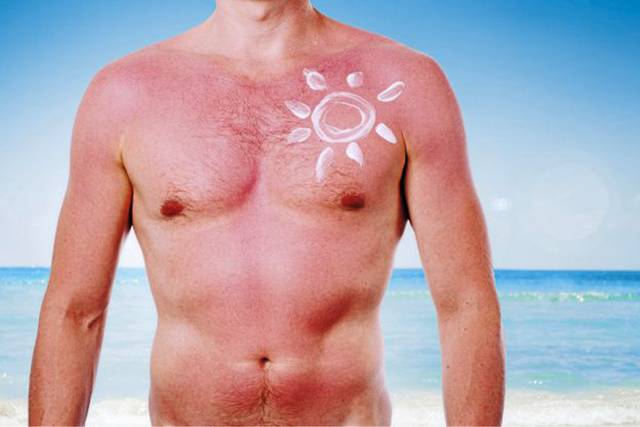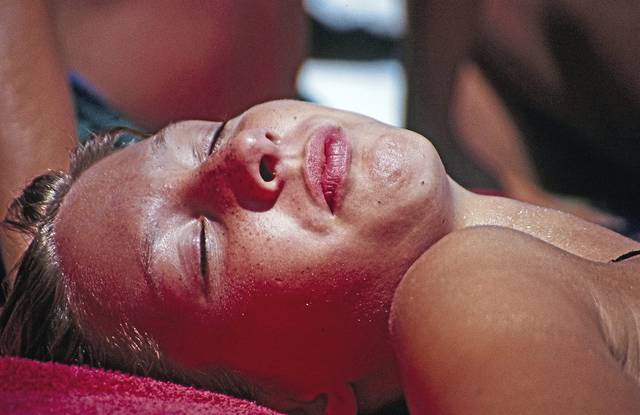Sunburn tattoos? Don't put your skin at risk, dermatologists say
Even if it’s not a good idea, somebody is bound to try it.
Witness this summer’s social media buzz around “sunburn tattoos.”
To create sunburn tattoos, tanners cover a portion of skin with a decal, stencil or sunscreen and then head out into the sun with the rest of their skin unprotected. Or, they use sunscreen on most of their skin, leaving a small portion exposed to create the tattoo effect.
Either way, dermatologists aren’t as enthusiastic about it as those sharing their painful-looking photos — for examples, check out #sunburntattoos on Instagram.
Dr. Lawrence Stokar, chief, Division of Dermatology at UPMC McKeesport and AHN Jefferson Hospital, says none of his patients have sought treatment for a sunburn tattoo gone wrong but, nevertheless, “It’s a very unhealthy practice to create that kind of a tattoo by irradiating the skin.”
“At first glance it may look like harmless fun in the sun. The bottom line is that sunburn tattoos are extremely dangerous and can put you at serious risk of skin cancer,” says Dr. Manish Shah, a Denver-based plastic surgeon.
Don’t try this at home
Inked, a magazine for tattoo artists and aficionados, traces the practice to “Illustrated People,” a 2015 project by French multi-media artist Thomas Mailaender. Mailaender put photographic negatives onto people’s skin and used ultraviolet light to create a burn to contrast with the surrounding skin.
“And while we’re the first to say that the results of Mailaender’s project are stunning, we’d highly discourage our readers trying these techniques at home,” the magazine says. “Because while the results may look cool in the moment, your health should never be jeopardized at the cost of art.”
Sun damage leading to skin cancer is “epidemic,” Stokar says, and no skin type — from the lightest to the darkest — is immune to it: “The misconception is, ‘I tan well, so I’m safe.’ If you spend a typical day in a dermatologist’s office, you’ll see patients with skin cancer coming in all day long. I treat thousands of cases every year.
“They say the most damage occurs in the first 10 years of life, but we can certainly add to it over the years,” he says.”
Numbers have risen throughout his 32 years of practice too, Stokar says — especially melanoma in young women who frequent tanning salons.
The best way to get some color in your skin is to use a sunless tanning product, he says, but if you are determined to do it the old-fashioned way, “you will tan through sunscreen.” The key is to use the sunscreen and tan gradually without burning.
Lots of summer left
Still, we’re just entering the dog days of August, and there’s plenty of summer left for people to be on the beach, at the ball field, hiking, biking and enjoying other outdoor activities. Especially in colder climates, many people want to be outside as much as possible while the weather is good.
But, as the old saying goes, an ounce of prevention is worth a pound of cure.
According to the Centers for Disease Control, “The sun’s ultraviolet (UV) rays can damage your skin in as little as 15 minutes.”
“Sun protection is essential to skin cancer prevention — about 90% of non-melanoma skin cancers and about 86% of melanomas are associated with exposure to UV radiation from the sun,” according to the Skin Cancer Foundation.
Here are a few simple tips from the CDC for staying sun safe:
• Slather on the sunscreen — Apply a broad-spectrum sunscreen with at least SPF 15 before going outside, even if the day is semi-cloudy or cool. The higher the SPF number, the heavier the protection.
• Seek the shade — An umbrella, tree or awning can provide a respite from the sun.
• Cover up — Long-sleeved shirts, pants, tightly woven fabrics and darker colors provide the best protection. Some fabrics now have an ultraviolet protection factor. Don’t forget your hat.
• Easy on the eyes — Sunglasses protect your precious peepers from UV rays, reduce the risk of cataracts and also protect delicate skin around the eyes. Even most cheap sunglasses sold in the U.S. will block both UVA and UVB rays. Wraparounds provide the most protection.
Stokar also suggests doing yard work or gardening before 10 a.m. or after 4 p.m., if possible, to minimize sun exposure.
Shirley McMarlin is a Tribune-Review staff writer. You can contact Shirley by email at smcmarlin@triblive.com or via Twitter .
Remove the ads from your TribLIVE reading experience but still support the journalists who create the content with TribLIVE Ad-Free.


